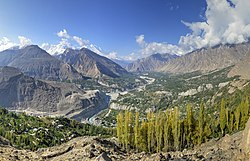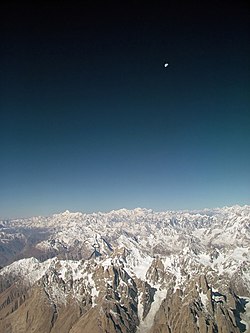Karakoram
The Karakoram (/ˌkɑːrəˈkɔːrəm, ˌkær-/) is a mountain range in the Kashmir region spanning the border of Pakistan, China, and India, with the northwestern extremity of the range extending to Afghanistan and Tajikistan. Most of the Karakoram mountain range is within Pakistan's Gilgit-Baltistan region, the northern subdivision of Kashmir.
Karakoram's highest and the world's second-highest peak, K2, is located in Gilgit-Baltistan. The mountain range begins in the Wakhan Corridor in Afghanistan in the west, encompasses the majority of Gilgit-Baltistan, controlled by Pakistan and then extends into Ladakh, controlled by India and Aksai Chin, controlled by China. It is part of the larger Trans-Himalayan mountain ranges.
The Karakoram is the second-highest mountain range on Earth and part of a complex of ranges that includes the Pamir Mountains, Hindu Kush, and the Indian Himalayas.
The range contains 18 summits higher than 7,500 m (24,600 ft) in elevation, with four above 8,000 m (26,000 ft): K2 (8,611 m (28,251 ft) AMSL) (the second-highest peak on Earth), Gasherbrum I, Broad Peak, and Gasherbrum II.
The range is about 500 km (311 mi) in length and is the most glaciated place on Earth outside the polar regions. The Siachen Glacier (76 km (47 mi) long) and Biafo Glacier (63 km (39 mi) long) are the second- and third-longest glaciers outside the polar regions.
The Karakoram is bounded on the east by the Aksai Chin plateau, on the northeast by the edge of the Tibetan Plateau and on the north by the river valleys of the Yarkand and Karakash rivers beyond which lie the Kunlun Mountains. At the northwest corner are the Pamir Mountains. The southern boundary of the Karakoram is formed, west to east, by the Gilgit, Indus and Shyok rivers, which separate the range from the northwestern end of the Himalaya range proper. These rivers flow northwest before making an abrupt turn southwestward towards the plains of Pakistan. Roughly in the middle of the Karakoram range is the Karakoram Pass, which was part of a historic trade route between Ladakh and Yarkand that is now inactive.
The Tashkurghan National Nature Reserve and the Pamir Wetlands National Nature Reserve in the Karalorun and Pamir mountains have been nominated for inclusion in UNESCO in 2010 by the National Commission of the People's Republic of China for UNESCO and have been tentatively added to the list.
Name

Karakoram is a Turkic term meaning black gravel. The Central Asian traders originally applied the name to the Karakoram Pass. Early European travellers, including William Moorcroft and George Hayward, started using the term for the range of mountains west of the pass, although they also used the term Muztagh (meaning, "Ice Mountain") for the range now known as Karakoram. Later terminology was influenced by the Survey of India, whose surveyor Thomas Montgomerie in the 1850s gave the labels K1 to K6 (K for Karakoram) to six high mountains visible from his station at Mount Haramukh in Kashmir Valley, codes extended further up to more than thirty.
In traditional Indian geography the mountains were known as Krishnagiri (black mountains), Kanhagiri and Kanheri.
Exploration
Due to its altitude and ruggedness, the Karakoram is much less inhabited than parts of the Himalayas further east. European explorers first visited early in the 19th century, followed by British surveyors starting in 1856.
The Muztagh Pass was crossed in 1887 by the expedition of Colonel Francis Younghusband and the valleys above the Hunza River were explored by General Sir George K. Cockerill in 1892. Explorations in the 1910s and 1920s established most of the geography of the region.
The name Karakoram was used in the early 20th century, for example by Kenneth Mason, for the range now known as the Baltoro Muztagh. The term is now used to refer to the entire range from the Batura Muztagh above Hunza in the west to the Saser Muztagh in the bend of the Shyok River in the east.

Floral surveys were carried out in the Shyok River catchment and from Panamik to Turtuk village by Chandra Prakash Kala during 1999 and 2000.
Geology and glaciers
The Karakoram is in one of the world's most geologically active areas, at the plate boundary between the Indo-Australian plate and the Eurasian plate. A significant part, somewhere between 28 and 50 percent, of the Karakoram Range is glaciated covering an area of more than 15,000 square kilometres or 5,800 square miles, compared to between 8 and 12 percent of the Himalaya and 2.2 percent of the Alps. Mountain glaciers may serve as an indicator of climate change, advancing and receding with long-term changes in temperature and precipitation. The Karakoram glaciers are slightly retreating, unlike the Himalayas where glaciers are losing mass at significantly higher rate, many Karakoram glaciers are covered in a layer of rubble which insulates the ice from the warmth of the sun. Where there is no such insulation, the rate of retreat is high.
- Siachen Glacier
- Baltoro Glacier
- Hispar Glacier
- Batura Glacier
- Biafo Glacier
- Chogo Lungma Glacier
- Yinsugaiti Glacier
Ice Age
In the last ice age, a connected series of glaciers stretched from western Tibet to Nanga Parbat, and from the Tarim basin to the Gilgit District. To the south, the Indus glacier was the main valley glacier, which flowed 120 kilometres (75 mi) down from Nanga Parbat massif to 870 metres (2,850 ft) elevation. In the north, the Karakoram glaciers joined those from the Kunlun Mountains and flowed down to 2,000 metres (6,600 ft) in the Tarim basin.
While the current valley glaciers in the Karakoram reach a maximum length of 76 kilometres (47 mi), several of the ice-age valley glacier branches and main valley glaciers, had lengths up to 700 kilometres (430 mi). During the Ice Age, the glacier snowline was about 1,300 metres (4,300 ft) lower than today.
Highest peaks

Legend:
1:K2, 2:Gasherbrum I, K5, 3:Broad Peak, 4:Gasherbrum II, K4, 5:Gasherbrum III, K3a, 6:Gasherbrum IV, K3, 7:Distaghil Sar, 8:Kunyang Chhish, 9:Masherbrum, K1, 10:Batura Sar, Batura I, 11:Rakaposhi, 12:Batura II, 13:Kanjut Sar, 14:Saltoro Kangri, K10, 15:Batura III, 16: Saser Kangri I, K22, 17:Chogolisa, 18:Shispare, 19:Trivor Sar, 20:Skyang Kangri, 21:Mamostong Kangri, K35, 22:Saser Kangri II, 23:Saser Kangri III, 24:Pumari Chhish, 25:Passu Sar, 26:Yukshin Gardan Sar, 27:Teram Kangri I, 28:Malubiting, 29:K12, 30:Sia Kangri, 31:Momhil Sar, 32:Skil Brum, 33:Haramosh Peak, 34:Ghent Kangri, 35:Ultar Sar, 36:Rimo massif, 37:Sherpi Kangri, 38:Yazghil Dome South, 39:Baltoro Kangri, 40:Crown Peak, 41:Baintha Brakk, 42:Yutmaru Sar, 43:K6, 44:Muztagh Tower, 45:Diran, 46:Apsarasas Kangri I, 47:Rimo III, 48:Gasherbrum V
Here is a list for the highest peaks of the Karakoram. Included are some of the mountains named with a K code, the most famous of which is the K2 (mountain).
The majority of the highest peaks are in the Gilgit–Baltistan region administered by Pakistan. Baltistan has more than 100 mountain peaks exceeding 6,100 metres (20,000 ft) height from sea level.
Subranges

The naming and division of the various subranges of the Karakoram is not universally agreed upon. However, the following is a list of the most important subranges, following Jerzy Wala. The ranges are listed roughly west to east.
- Batura Muztagh
- Rakaposhi-Haramosh Mountains
- Spantik-Sosbun Mountains
- Hispar Muztagh
- South Ghujerab Mountains
- Panmah Muztagh
- Wesm Mountains
- Masherbrum Mountains
- Baltoro Muztagh
- Saltoro Mountains
- Siachen Muztagh
- Rimo Muztagh
- Saser Muztagh
Passes
Legend:
![]() 1:Sia La,
1:Sia La, ![]() 2:Bilafond La,
2:Bilafond La, ![]() 3:Gyong La,
3:Gyong La, ![]() 4:Sasser Pass,
4:Sasser Pass, ![]() 5:Burji La,
5:Burji La, ![]() 6:Machulo La,
6:Machulo La, ![]() 7:Naltar Pass,
7:Naltar Pass, ![]() 8:Hispar Pass,
8:Hispar Pass, ![]() 9:Shimshal Pass,
9:Shimshal Pass, ![]() 10:Karakoram Pass,
10:Karakoram Pass, ![]() 11:Turkistan La Pass,
11:Turkistan La Pass, ![]() 12:Windy Gap,
12:Windy Gap, ![]() 13:Mustagh Pass,
13:Mustagh Pass, ![]() 14:Sarpo Laggo Pass,
14:Sarpo Laggo Pass, ![]() 15:Khunjerab Pass,
15:Khunjerab Pass, ![]() 16:Mutsjliga Pass,
16:Mutsjliga Pass, ![]() 17:Mintaka Pass,
17:Mintaka Pass, ![]() 18:Kilik Pass
18:Kilik Pass
Passes from west to east are:
- Dandala Pass is the most important and earlier pass. It starts from Ghursay saitang city to Yarqand in China. It is the main trade route between Khaplu, Ladakh, Kharmang to Yarqand, China.
- Kilik Pass
- Mintaka Pass
- Khunjerab Pass is the highest paved international border crossing at 4,693 m (15,397 ft). It serves the China-Pakistan Friendship Highway, the "8th world wonder".
- Shimshal Pass
- Mustagh Pass
- Karakoram Pass
- Sasser Pass
- Naltar Pass or Pakora Pass
The Khunjerab Pass is the only motorable pass across the range. The Shimshal Pass (which does not cross an international border) is the only other pass still in regular use.
Cultural references
The Karakoram mountain range has been referred to in a number of novels and movies. Rudyard Kipling refers to the Karakoram mountain range in his novel Kim, which was first published in 1900. Marcel Ichac made a film titled Karakoram, chronicling a French expedition to the range in 1936. The film won the Silver Lion at the Venice Film Festival of 1937. Greg Mortenson details the Karakoram, and specifically K2 and the Balti, extensively in his book Three Cups of Tea, about his quest to build schools for children in the region. K2 Kahani (The K2 Story) by Mustansar Hussain Tarar describes his experiences at K2 base camp.
See also
- Karakoram Highway
- List of mountain ranges of the world
- List of highest mountains (a list of mountains above 7,200 m (23,600 ft))
- Mount Imeon
- Naltar Valley
- Trans-Karakoram Tract
References
Citations
Sources
Further reading
- Dainelli, G. (1932). A Journey to the Glaciers of the Eastern Karakoram. The Geographical Journal, 79(4), 257–268.
External links
- Blankonthemap The Northern Kashmir Website
- Pakistan's Northern Areas dilemma
- Great Karakorams – images on Flickr

